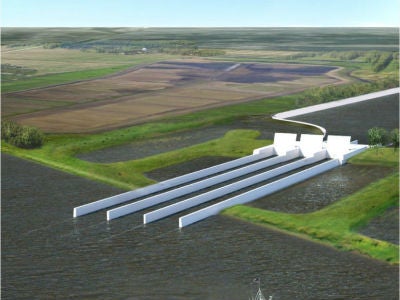Decoding Diversion Permitting: What the Federal Dashboard Means for Restoring Coastal Louisiana
It’s official! The Federal Permitting Dashboard has been updated for the Mid-Barataria Sediment Diversion project! The CPP is revised! Most importantly, the target date for completing permitting has moved up by almost two years! It’s pretty cool stuff, but you might be asking, “What’s a dashboard?” or “What is a CPP?!” So allow us to explain.
The Mid-Barataria Sediment Diversion project will reconnect the Mississippi River with the wetlands in the Barataria Basin, an area with one of the highest land loss rates in the world, delivering the sand and mud that builds coastal land. The diversion will work in concert with large-scale marsh creation and ridge restoration to restore a functional delta ecosystem. That means a basin with a range of salinities from fresh to salty, and a range of habitats from cypress swamp to salt marshes. A functional ecosystem can deliver a range of valuable services, including putting more land between communities and storm surge, providing a nursery ground for fish and shrimp and harboring a thriving commercial fishing industry.
What is the Federal Dashboard?
This project is a linchpin of the Coastal Master Plan. Without it, nearby restoration attempts such as marsh creation will sink over time due to lack of sediment. It is essential to build Mid-Barataria as quickly as possible. To get started, the project must undergo an environmental review to assess the changes that might occur if it is built and the resulting impacts. Environmental reviews are important to ensure that projects are designed and built in a manner that protects public health, safety and the environment. However, reviews of large, complex projects take time — sometimes five years or more. The Barataria Basin doesn’t have that long to wait! In 2016, Congress created the Federal Infrastructure Permitting Dashboard as a tool to ensure transparency, accountability and interagency coordination in the permitting of large, complex projects. The Mid-Barataria Sediment Diversion stands proudly as the first restoration project to be placed on the national Dashboard.
What is a CPP?
The Dashboard provides an online space where the permitting timelines for covered projects are posted and tracked, giving the public a window into the environmental review process. It accomplishes this by requiring all of the agencies with a role in permitting the project to come together early on, and to develop a detailed plan — called a Coordinated Project Plan (CPP). This CPP clearly spells out all of the required permits and authorizations for the project and assigns responsibilities and deadlines for completing them. It allows (and encourages) reviews to happen simultaneously where possible and promotes increased communication on the front end of the project, to avoid delays later. Importantly, the CPP must be updated quarterly, providing an opportunity four times a year for the participating agencies to demonstrate that they are meeting (or beating!) deadlines.
Anyone can access the Dashboard online, review the timeline and use the information to hold the agencies accountable to their commitment. Again, this allows the public to see if the timeline has slipped, or if it has in fact been accelerated. Mid-Barataria first appeared on the Dashboard in February 2017. The timeline posted then set a target date of April 2022 — more than five years before construction could begin! Ouch! Fortunately, the agencies involved continued to look for time saving options. The most recent quarterly update for Mid-Barataria actually cut almost 2 years from the permitting timeline! WOOHOO! The target date for completing the permit process for Mid-Barataria is now November 2020. This date is certainly more in keeping with urgency of the project.
Click here to learn more about the critically important Mid-Barataria Sediment Diversion.
